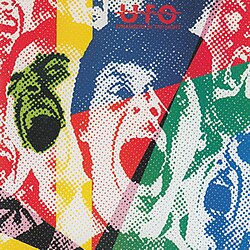Hipgnosis
Hipgnosis was a British art design group which specialized in creating cover art for the albums of rock musicians and bands, most notably Pink Floyd, Genesis, Led Zeppelin, Yes and Black Sabbath. Hipgnosis consisted primarily of Storm Thorgerson, Aubrey Powell and Peter Christopherson. The group dissolved in 1983, but Thorgerson still works on album designs.
History
In 1968 Thorgerson and Powell were asked by their friends in Pink Floyd, if they were interested in designing the cover for their second album, A Saucerful of Secrets. They did, and did additional work for EMI, including photos and album covers for Free, Toe Fat and The Gods. Being film and art school students, they were able to use the darkroom at the Royal College of Art, but when they completed school, they had to set up their own facilities. They built a small darkroom in Powell's bathroom, but shortly thereafter, in early 1970, rented space and built a studio.
When first starting out, Powell and Thorgerson adopted their name from graffiti they found on the door to their apartment. They liked the word, not only for sounding like "hypnosis," but for combining two somewhat contradictory terms, "hip", or new and cool, with "gnosis," relating to ancient learning.
Hipgnosis got its big break in 1973, with the cover for Pink Floyd's Dark Side of the Moon. The record itself was wildly successful, which put it in the hands of millions of fans, and it has since been hailed as one of the best album covers of all time (VH1 rated the cover as #5, in 2003). After that, the firm became in-demand, and did many covers for high-profile bands and artists such as Led Zeppelin, Genesis, UFO, Peter Gabriel and The Alan Parsons Project. They also designed the cover for the original UK paperback edition of Douglas Adamss' The Hitchhiker's Guide to the Galaxy.
Peter Christopherson joined Hipgnosis as an assistant, in 1974, and later became a full partner. The firm employed many assistants and other staff members, over the years. Of particular note were freelance artists, George Hardie, Colin Elgie, Richard Evans and Richard Manning.
One notable fact was that Hipgnosis did not have a set fee for designing an album cover but instead asked the artists to "pay what they thought it was worth," a policy that only occasionally backfired according to Thorgerson in his book on album cover design.
Style
Hipgnosis' approach to album design was strongly photography-oriented, and they pioneered the use of many innovative visual and packaging techniques. In particular, Thorgerson & Powell's surreal, elaborately manipulated photos (utilizing darkroom tricks, airbrush retouching, and mechanical cut-and-paste techniques) were a film-based forerunner of what would, much later, be called photoshopping. Hipgnosis used primarily Hasselblad medium format cameras for their work, the square film format being especially suited to album cover imagery.
Another Hipgnosis trademark was that many of their cover photos told "stories" directly related to the album's lyrics. Since both Powell and Thorgerson were film students, they often used models as "actors" and staged the photos in a highly theatrical manner. Hipgnosis covers rarely featured artists' photos on the outside, and most were in a gatefold cover format to provide ample space for their slickly photographed tableaux.
Many of Hipgnosis' covers also featured distinctively "high tech" pen and ink logos and illustrations (often by graphic designer George Hardie), stickers, fancy inner sleeves, and other packaging goodies.
Catalogue of Work
- Alphabet City, ABC, 1987
- The Alan Parsons Project
- Audience
- 1971, House on the Hill
- 1972, Lunch
- 1973, You Can't Beat 'em
- Led Zeppelin
- Pink Floyd
- 1968, A Saucerful of Secrets
- 1969, Ummagumma
- 1970, Atom Heart Mother
- 1971, Meddle
- 1971, Relics
- 1972, Obscured by Clouds
- 1973, The Dark Side of the Moon
- 1974, A Nice Pair
- 1975, Wish You Were Here
- 1977, Animals
- 1987, A Momentary Lapse of Reason
- 1981, A Collection of Great Dance Songs
- 1994, The Division Bell

- Al Stewart
- UFO
- Cochise, Cochise, 1970
- The Madcap Laughs, Syd Barrett, 1970
- Electric Warrior, T. Rex, 1971
- Elegy, The Nice, 1971
- Argus, Wishbone Ash, 1972
- Thunderbox, Humble Pie, 1974
- Uno, Uno, 1974
- Bad Company, Bad Company, 1974
- Alberto Y Lost Trios Paranoias, Alberto Y Lost Trios Paranoias, 1975
- The Original Soundtrack, 10cc, 1975
- Straight Shooter, Bad Company, 1975
- Savage Eye, Pretty Things, 1975
- Cunning Stunts, Caravan, 1975
- HQ, Roy Harper, 1975
- Venus and Mars, Wings, 1975
- Dirty Deeds Done Dirt Cheap, AC/DC, 1976
- Jump On It, Montrose, 1976
- Wings at the Speed of Sound, Wings, 1976
- Wings over America, Wings, 1976
- How Dare You!, 10cc, 1976
- Peter Gabriel (I), Peter Gabriel, 1977
- Burnin' Sky, Bad Company, 1977
- Sammy Hagar, Sammy Hagar, 1977
- Deceptive Bends, 10cc, 1977

- Going for the One, Yes, 1977
- Peter Gabriel (II), Peter Gabriel, 1978
- Wet Dream, Richard Wright, 1978
- David Gilmour, David Gilmour, 1978
- Pieces of Eight, Styx, 1978
- Tormato, Yes, 1978
- Bloody Tourists, 10cc, 1978
- A Song for All Seasons, Renaissance, 1978
- Back to the Bars, Todd Rundgren, 1978
- Go 2, XTC, 1978
- Live Herald, Steve Hillage, 1979
- Lovedrive, Scorpions, 1979
- Desolation Angels, Bad Company, 1979
- Def Leppard
- Freeze Frame, Godley & Creme, 1979
- Danger Money, UK, 1979
- Peter Gabriel (III), Peter Gabriel, 1980
- Difficult to Cure, Rainbow, 1980
- Do They Hurt?, Brand X, 1980
- Fictitious Sports, Nick Mason, 1981
- Fun in Space, Roger Taylor, 1981
- High 'n' Dry, Def Leppard, 1981
- Quark, Strangeness and Charm, Hawkwind, 1977
- Sakuban oai shimasho, Yumi Matsutoya, 1981
- Tug of War, Paul McCartney, 1982
- Rough Diamonds, Bad Company, 1982
- Tightly Knit, Climax Blues Band
- Toe Fat, Toe Fat
